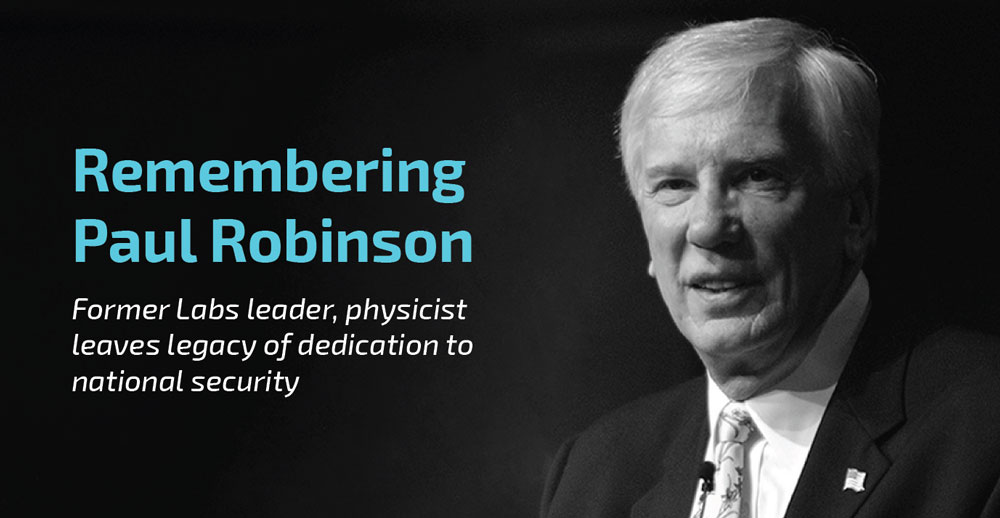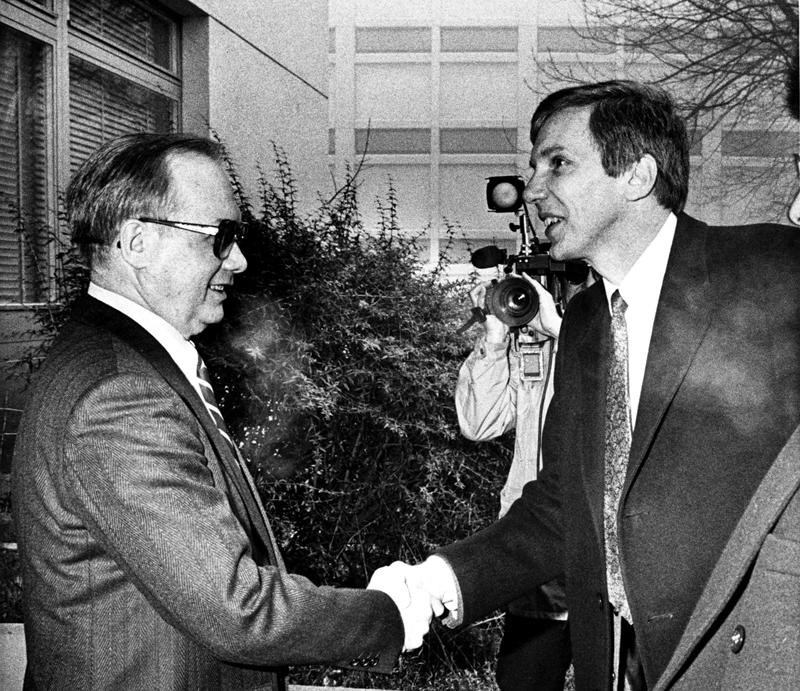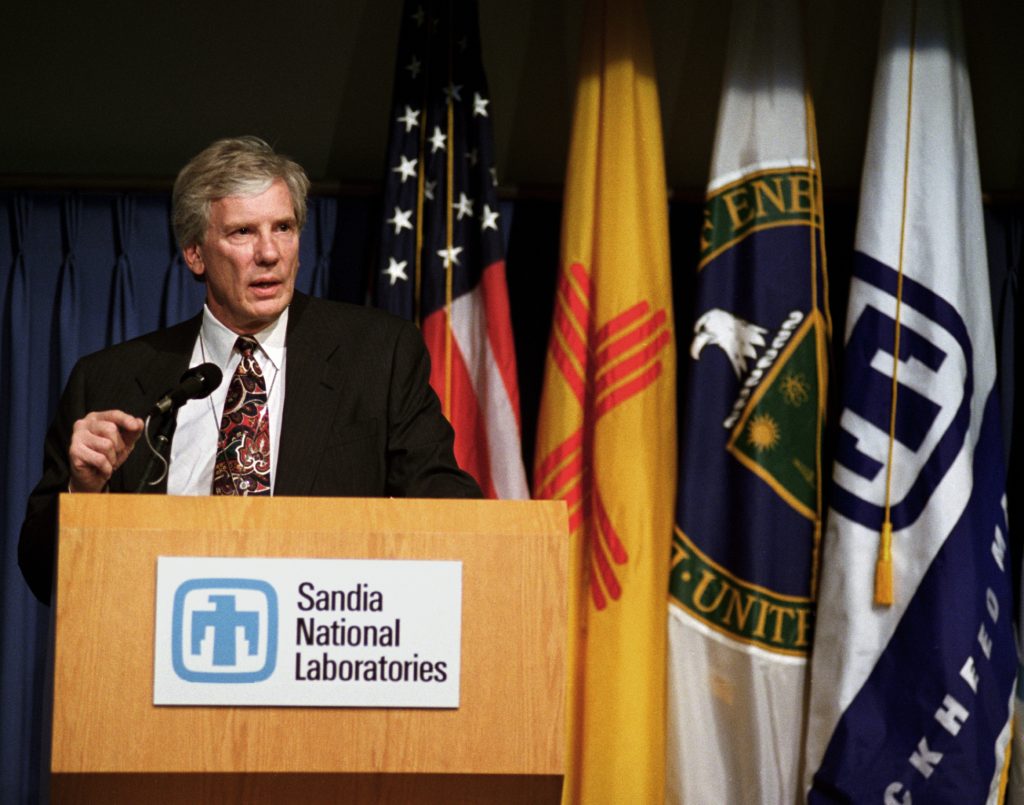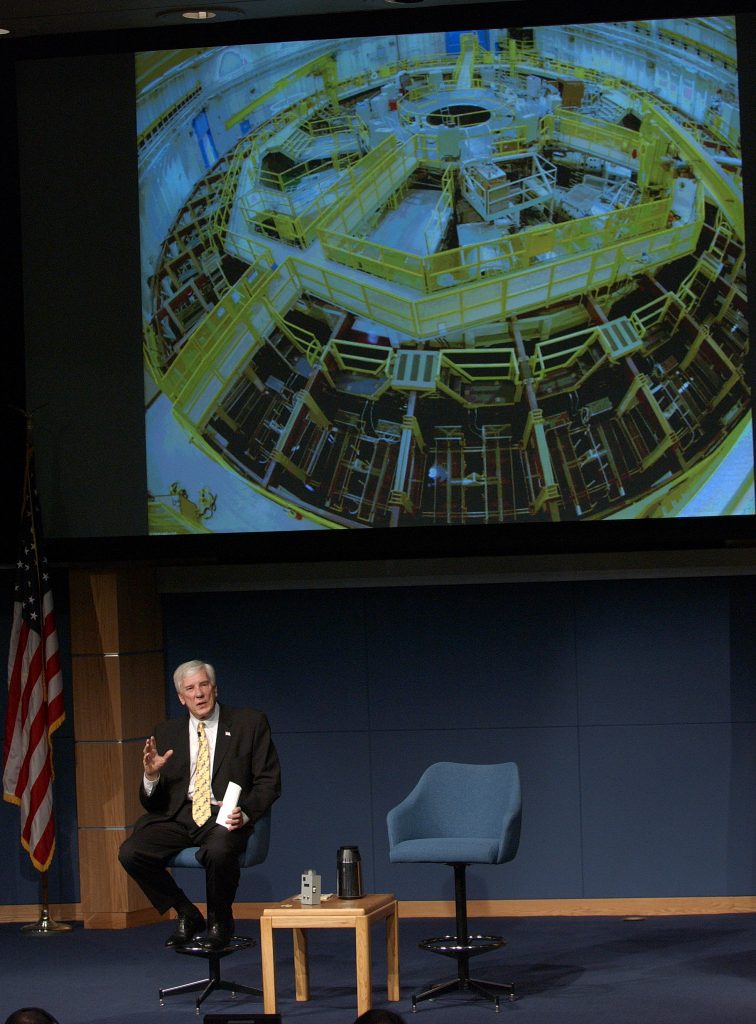
Paul Robinson, an award-winning physicist, U.S. ambassador and former head of Sandia National Laboratories, died Thursday, March 2. He was 81. From Aug. 15, 1995, to April 29, 2005, he successfully guided the workforce through lean and difficult times toward relative stability and growth, while overseeing buildups in stockpile surveillance, anti-terrorism and industrial partnerships. He was known as an effective communicator, a generous administrator and a man who committed his life absolutely to national security.
Paul was born Oct. 9, 1941, in Detroit. He received a bachelor’s in physics from Christian Brothers University in Memphis, Tennessee, where he grew up, and a doctorate, also in physics, from Florida State University. At FSU, he worked in the nuclear accelerator laboratory studying alpha particle scattering on calcium-40 under physicist Robert H. Davis. Paul entered the workforce at Los Alamos National Laboratory in 1967 in field testing. He moved into the Advanced Concepts Group and up through management, becoming principal associate director of the National Security Program in 1980.
He left Los Alamos in 1985 to serve for three years as senior vice president and principal scientist at Ebasco Services Inc. He sat on a White House committee headed by former CIA Director William Casey that reviewed compliance with arms control agreements for the National Security Council. Paul successfully pushed for the report to include considerations of the technologies involved, reflecting his experience in nuclear deterrence and other national security programs.

His technical background was recognized when, in 1988, then-President Ronald Reagan named him U.S ambassador to the Nuclear Testing Talks in Geneva, a post to which he was reappointed by former President George H. W. Bush. As ambassador, he headed the delegation and was its chief negotiator. The talks resulted in protocols to the Threshold Test Ban Treaty and the Peaceful Nuclear Explosions Treaty, both ratified unanimously by the U.S. Senate and the Soviet Duma.
In 1990, Paul joined Sandia as director of the Systems Analysis Center and in 1991 advanced to vice president — comparable to a current associate Labs director — for Laboratory Development. Throughout his career, he continued to provide his expertise to government reviews of arms control and national security policy. In 1991, he chaired the President’s Technical Advisory Committee for arms control issues related to warhead dismantlement and special nuclear materials and was a member of the Strategic Advisory Group for U.S. Strategic Command.
In 1995, Paul was named director of Sandia National Laboratories and president of Sandia Corp. He would become Sandia’s longest serving director.
When he became Sandia’s leader, the Labs was still adjusting to the end of the Cold War. Nuclear testing had ended in 1992, and no new nuclear weapon designs were in development. Upon his appointment, he announced his faith in Sandia, “I can tell you that our laboratory is certainly among the best in the world. The can-do attitude we bring to problem solving is unrivaled.” However, he admitted hurdles, such as overly complex internal processes, needed to be overcome, and he pledged to “turn up the rate of idea generation, competition and continuous improvement.” True to his word, he went on to become the Labs’ biggest advocate for new ideas and continuous improvement.

He continued to champion efforts to significantly expand partnerships with industry. He oversaw the implementation of the new Stockpile Surveillance program and the related Accelerated Strategic Computing Initiative. He supported international programs that initially focused on the protection of nuclear information and materials held by the states of the former Soviet Union. And he encouraged the extension of Sandia’s anti-terrorism research, building on the Labs’ solid base in physical security.
Under Paul, Sandia saw its first woman promoted to executive vice president. Joan Woodard became vice president of the Energy and Environment Division in October 1995, under a restructuring by Paul and Deputy Lab Director John Crawford. Four years later, she took John’s place as executive vice president. She and Paul worked closely together for the remainder of his tenure.
Paul was courageous about both the complexities and the importance of nuclear deterrence and nuclear security. He spoke to Congress clearly, calmly and optimistically about the 1988-1992 Geneva negotiations that established protocols for the Peaceful Nuclear Explosions and Threshold Test Ban treaties. In 1988, before an initially skeptical congressional committee, he asserted the progress made and emphasized the unprecedented breakthroughs in communication between the U.S. and the USSR in preparing for the Joint Verification Experiment, in which each side observed and shared data on the other’s nuclear test. He was not naive but expressed his belief that the “atmosphere we have set I’m sure will serve us well in future negotiations.” In the end, the verification experiment was a success, the protocols were finalized and both treaties were ratified.
He also spoke bluntly about security within the national labs when Los Alamos came under fire in the late 1990s. He was upfront in telling the Sandia workforce about the security stand-down they were about to undergo, and he pushed back on anti-Asian rhetoric. In 1999, when all three weapons lab directors testified before Congress on the security of classified information, Paul stepped forward in advocating for advanced security processes and technologies. He was direct about the endless game of leapfrog between defenders and attackers in protecting electronic information and was confident in the ideas that would keep the defenders in front.

The response to 9/11 best illustrated Paul’s leadership. He answered calls from Washington, D.C., immediately with insight, expertise and assistance based on Sandia’s established anti-terrorism technical capabilities. He had Sandians in the air to D.C. when all other flights were grounded. Paul was able to envision right away what the Labs could offer to the nation to solve suddenly new, or at least suddenly understood, problems.
In addition to dispatching the right experts externally and internally, Paul communicated reassurance and inspiration to the workforce. At the time, Labswide announcements were often made through voice messages. Paul recorded a message to the Albuquerque workforce on the morning of 9/11, asking all to stop work and leave Kirtland Air Force Base. His voice, calm and resonant, allowed those unsure what they could do about the crisis to focus, and to remember that they soon would be called upon to serve national security. In the subsequent days, months and years, Sandians have served, because Paul ensured their innovation and expertise would be used effectively.
Sandia surged forward after 9/11, responding both to demands for anti-terrorism technologies and the ongoing need to sustain the nuclear deterrent. The programs that expanded in the wake of 9/11 and Paul’s continual emphasis on national security now thrive in everything from the life extension programs through MESA and bioterror research to nonproliferation and arms control efforts.
In April 2005, Paul stepped down from his leadership roles. He became an adviser to Lockheed Martin Corp.’s Information and Technology Services, then retired from Sandia and Lockheed in January 2006. He continued to serve on a variety of government panels and committees addressing national security concerns and was involved with the National Academies and their efforts to merge and leverage their different interests.
Paul was honored nationally for his technical expertise and his leadership. He received the Outstanding Public Service Medal from the Joint Chiefs of Staff and, in 2003, was awarded the George E. Pake Prize from the American Physical Society.
The American Nuclear Society honored him with the Smyth Nuclear Statesman Award for 40 years of contributions to national nuclear efforts. He also received the New Mexico Governor’s Distinguished Citizen Award and the Department of Energy Secretary’s Gold Award. In addition to the APS and ANS, he was a member of the American Association for the Advancement of Science and the National Academy of Engineering.